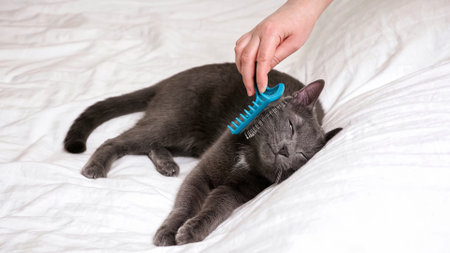Understanding Why Cats Shed
If you’ve ever found yourself constantly vacuuming cat hair from your sofa or lint-rolling your favorite black hoodie, you’re not alone. Shedding is a completely natural part of a cat’s life, but understanding why it happens can make managing it much less frustrating. Cats shed for several reasons, primarily as part of their natural hair growth cycle. As seasons change—especially from winter to spring—many cats lose their thick undercoat in preparation for warmer weather. This process is influenced by daylight hours, temperature, and indoor living conditions.
Breed Differences: Not All Cats Shed Alike
It’s important to know that some breeds are heavier shedders than others. For example, Maine Coons and Ragdolls have long, dense fur and tend to shed more noticeably than short-haired breeds like the American Shorthair or Siamese. Meanwhile, hairless breeds such as Sphynx technically don’t shed fur but still produce skin oils that require regular cleaning. Getting familiar with your cat’s breed-specific habits can help set realistic expectations for the amount of shedding you’ll encounter.
What’s Normal Shedding?
While all cats shed to some extent, how much is “normal” can vary. A moderate amount of loose hair on bedding or clothing is expected, especially during seasonal changes. However, if you start to notice bald patches, excessive scratching, or sudden increases in shedding, this could signal an underlying health issue such as allergies, stress, or skin conditions. If you’re concerned about the level of shedding or your cat’s overall coat health, it’s always a good idea to consult your veterinarian.
The Takeaway
Understanding why cats shed—and recognizing what’s typical for your pet—lays the foundation for effective management at home. With a little knowledge and some practical strategies, keeping cat hair under control doesn’t have to feel overwhelming.
Regular Grooming Tips
Keeping your cat’s shedding under control starts with a solid grooming routine. For American pet parents, making grooming a regular part of your cat’s week doesn’t have to be a struggle—in fact, it can become a special bonding time if approached the right way.
How Often Should You Groom?
The frequency depends on your cat’s coat type. Here’s a quick guide:
| Coat Type | Recommended Frequency |
|---|---|
| Short-haired | 1-2 times per week |
| Medium-haired | 2-3 times per week |
| Long-haired | 3-4 times per week |
Best Brushes and Tools for Shedding Control
- Slicker Brush: Great for removing loose hair and detangling, especially for long-haired breeds.
- Deshedding Tool (like the FURminator): Designed to reach deep undercoats and reduce shedding up to 90%—a favorite among American cat owners.
- Rubber Grooming Glove: Perfect for short-haired cats who may be nervous around traditional brushes; plus, it doubles as a petting session.
- Comb with Rotating Teeth: Gentle on sensitive skin and helpful for preventing mats in medium to long-haired cats.
Tips for Making Grooming Part of Your Routine
- Create a Calm Space: Choose a quiet spot in your home where your cat feels safe—maybe their favorite sunny perch or cozy corner.
- Keep Sessions Short and Sweet: Start with just a few minutes, gradually increasing as your cat gets used to the process.
- Treats Go a Long Way: Reward your kitty with their favorite treat after each grooming session to reinforce positive associations.
- Set a Reminder: Use your phone or an old-school calendar to schedule regular grooming days, just like you would vet appointments or family events.
A Quick Weekly Grooming Checklist
- Check for tangles or mats, especially behind ears and under arms.
- Brush thoroughly using the recommended tool for your cat’s coat type.
- Wipe down fur with a damp cloth to pick up any remaining loose hairs.
- Praise and reward your cat at the end of each session!
This hands-on approach not only reduces cat hair in your home but also gives you quality time with your feline friend—making grooming less of a chore and more of an enjoyable ritual.

3. Cleaning Your Home Effectively
If you share your home with a cat, chances are you’re constantly battling stray fur on furniture, carpets, and clothing. Fortunately, keeping cat hair at bay is possible with a few smart strategies and tools that most American households already have on hand.
Furniture: Quick Fixes and Deep Cleans
To tackle cat hair on couches and chairs, start with a lint roller—one of the handiest tools for removing fur from upholstery. For larger surfaces or stubborn hair, put on a pair of slightly dampened rubber gloves and run your hands over the fabric; the static electricity helps lift hair easily. If you prefer gadgets, handheld vacuums designed for pet hair work wonders, especially models with motorized brush attachments.
Carpets and Rugs: Don’t Let Hair Settle In
Vacuuming regularly is key to preventing cat hair from embedding in carpet fibers. Opt for vacuums labeled as “pet-friendly” or those with HEPA filters to trap allergens. For spot cleaning, use a squeegee—the kind used for windows—to rake up hair from rugs or carpeted stairs. It’s an inexpensive hack that works remarkably well!
Clothing: Keep It Fur-Free
Before tossing clothes into the washer, give them a once-over with a sticky lint roller or adhesive tape. Dryer sheets are another American favorite—they help loosen pet hair during drying cycles so it ends up in the lint trap instead of sticking to your clothes. To prevent future buildup, designate a specific chair or blanket for your cat to relax on, making it easier to contain where most of the shedding happens.
Everyday Habits Make a Difference
Consistency is everything when managing cat hair. Establish a routine—vacuum two or three times per week, keep lint rollers handy near high-traffic spots, and wash throws or slipcovers regularly. With these habits and household staples, you can enjoy cuddle time with your feline friend without worrying about fur taking over your living space.
4. Best Products to Tackle Cat Hair
When it comes to managing cat hair in your home, the right products can make all the difference. U.S. households have trusted certain essentials for years, and with good reason—they work. Here’s a breakdown of tried-and-true solutions that help keep shedding under control.
Rolling Lint Brushes: Quick and Portable Solutions
Rolling lint brushes are a staple in American homes, especially for people with pets. These handheld tools use sticky adhesive sheets to pick up cat hair from clothing, furniture, and car seats. They’re great for quick touch-ups before you leave the house or when guests are on their way over.
Popular Options:
| Brand | Features | Best For |
|---|---|---|
| Scotch-Brite Lint Roller | Tear-resistant sheets, easy-grip handle | Everyday clothes and upholstery |
| OXO Good Grips FurLifter | Reusable brush, self-cleaning base | Frequent use, eco-friendly choice |
Vacuums: Deep Cleaning Powerhouses
A reliable vacuum cleaner is essential for keeping floors and carpets free from cat hair. Many U.S. brands now offer models specifically designed for pet owners, featuring specialized attachments and HEPA filters to capture even fine dander.
Top Picks:
| Model | Main Features | Where It Excels |
|---|---|---|
| Dyson Ball Animal 2 | Strong suction, tangle-free turbine tool | Carpets, rugs, and multi-pet homes |
| Bissell Pet Hair Eraser Turbo Plus | Specialized pet tools, Febreze filter | Sofas, stairs, hard-to-reach spots |
| Eufy RoboVac 11S | Slim design, scheduled cleaning option | Daily maintenance on hard floors |
Air Purifiers: Breathing Easy at Home
An often-overlooked source of relief from shedding is a high-quality air purifier. These devices pull airborne hair and dander out of circulation, which means less dust settling on surfaces—and easier breathing for allergy sufferers.
Recommended Models:
| Name | Key Feature | Why Choose It? |
|---|---|---|
| Levoit Core 300 | True HEPA filter, quiet operation | Apartments and bedrooms; budget-friendly option |
| Honeywell HPA300 | Covers large areas, allergen reduction mode | Larger living spaces or open floor plans |
The Bottom Line: Mix and Match for Maximum Impact
No single product is a magic bullet for cat shedding. Instead, combine these proven tools—rolling lint brushes for quick fixes, vacuums for deep cleaning sessions, and air purifiers for ongoing air quality improvement—to create a home environment that feels fresh and fur-free. Consistent use is key to staying ahead of the shed.
5. Maintaining a Healthy Cat Diet
Believe it or not, what your cat eats has a direct impact on how much they shed. A well-balanced diet supports healthy skin and a shiny coat, which means less hair around your home. In the United States, many cat owners opt for high-quality commercial foods that list real animal protein as the first ingredient—think brands like Blue Buffalo, Wellness, or Hill’s Science Diet. These premium foods are packed with essential nutrients such as Omega-3 and Omega-6 fatty acids, which help reduce excessive shedding by nourishing your cat’s skin from the inside out.
If your feline friend is still shedding more than usual, you might want to consider supplements. Fish oil and flaxseed oil are popular choices among American pet owners because they promote coat health and minimize dry, flaky skin—two major culprits behind extra shedding. Always consult your veterinarian before introducing new foods or supplements to ensure you’re giving your cat what’s best for their unique needs.
Remember, treats count too! Opt for healthy snacks like freeze-dried salmon or chicken that support skin and coat wellness rather than just empty calories. Consistency is key; feed your cat at regular times and stick to high-quality products. By keeping an eye on your kitty’s diet and making thoughtful choices, you’ll notice less fur tumbleweeding across your floors—and a happier, healthier pet.
6. When to Be Concerned About Excessive Shedding
While a certain amount of shedding is completely normal for cats, especially during seasonal changes, it’s important to recognize when hair loss might be pointing to an underlying health issue. Unlocking the difference between typical shedding and excessive hair loss can help you ensure your cat stays happy and healthy at home.
Recognizing Unusual Patterns
If you notice bald patches, thinning fur, or areas where the coat looks uneven, these could be red flags. Pay attention to whether your cat is constantly licking, scratching, or biting at particular spots—this kind of focused grooming often signals discomfort or irritation beyond routine shedding.
Other Warning Signs
- Redness, sores, or scabs on the skin
- Unpleasant odor coming from your cat’s skin or fur
- Lethargy or changes in appetite
- Noticeable weight loss
If any of these symptoms accompany the increased shedding, it’s time to consider that something more than just the usual molting may be happening.
When Should You Call Your Vet?
If you’re seeing persistent hair loss combined with the warning signs above, don’t wait it out. Conditions like allergies, parasites (like fleas), fungal infections (such as ringworm), hormonal imbalances, or even stress can all cause abnormal shedding. Early diagnosis and treatment make a big difference. In most American households, a call or visit to your local veterinarian is the best move if you feel something is off with your cat’s coat. Trust your instincts—when in doubt, it’s always better to get professional advice rather than risk your feline friend’s health.


